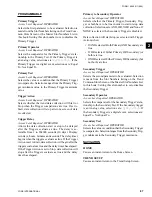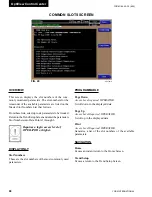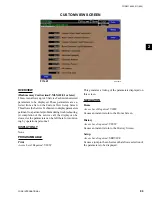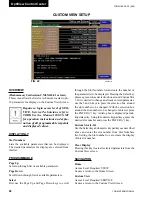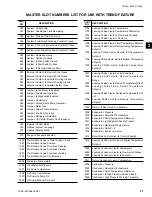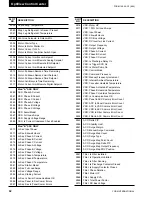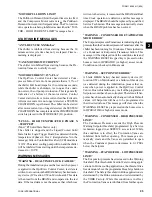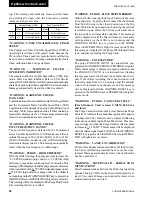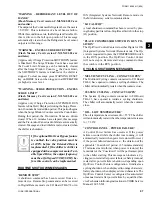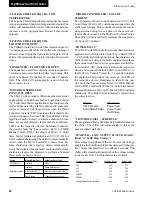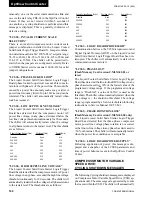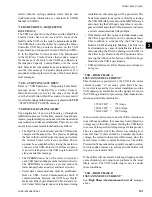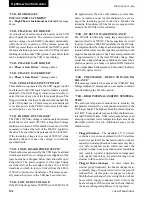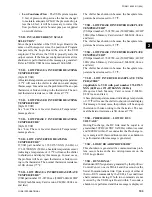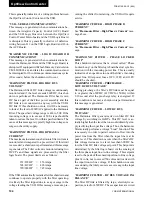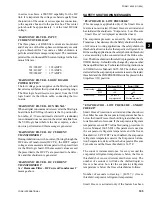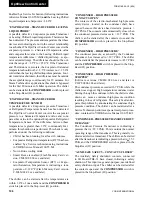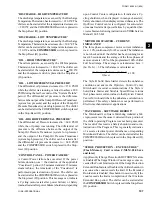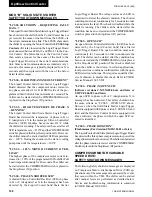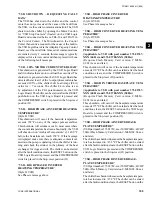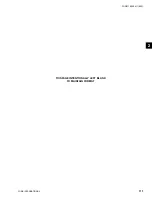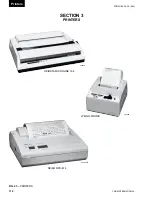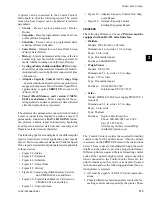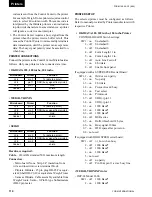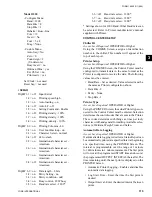
FORM 160.55-O1 (604)
101
YORK INTERNATIONAL
restart when the cycling condition clears. Ser vice and
troubleshooting information is con tained in YORK
Manual 160.00-M1.
“
VSD SHUTDOWN – REQUESTING
FAULT DATA
”
The VSD has shut down the chiller and the OptiView
Control Cen ter has not yet received the cause of the
fault from the VSD, via the serial communications link.
The VSD shuts down the chiller by opening the Motor
Controller VSD Stop Contacts (located on the VSD
Logic Board and connected between TB6-16 and TB6-
53 in the OptiView Control Center). The Microboard
in the OptiView Control Cen ter then sends a request
for the cause of the fault to the VSD Logic Board via
the Adaptive Capacity Control Board, over the serial
link. Since serial com mu ni ca tions are ini ti at ed every 2
sec onds, this message is typically dis played for a few
sec onds and then re placed with one of the below listed
fault messages.
“
VSD – STOP CONTACTS OPEN
”
Refer to “VSD Shutdown – Requesting Fault Data”
message above. If the OptiView Control Center’s
Microboard does not receive the cause of the Fault
over the Serial Link within 20 seconds, it is assumed it
is not forth com ing and that message is replaced with
VSD
– STOP CON TACTS OPEN message.
“
VSD INITIALIZATION FAILED”
Upon application of power, all boards go through the
ini tial iza tion process. At this time, memory locations are
cleared, program jumper positions are checked and se ri al
communications links are established. There are sev er al
causes for an unsuccessful ini tial iza tion as fol lows:
• The OptiView Control Center and the VSD must be
en er gized at the same time. The practice of pull ing
the fuse in the Control Center to remove pow er from
the Con trol Center will create a problem. Pow er-
up must be accomplished by closing the main dis-
con nect on the VSD cab i net with all fuses in place.
A power in ter rup tion to the VSD Logic board will
also gen er ate this mes sage.
• The EPROMS must be of the correct version for
each VSD board and they must be installed cor rect ly.
The EPROMS are created as a set and can not be
in ter changed be tween earlier and later ver sions.
• Serial data communications must be es tab lished.
Re fer to VSD - Serial Communications fault. If
com mu ni ca tions between the VSD Logic Board,
Har mon ic Filter Logic Board, ACC Board and Con-
trol Center Microboard does not take place during
ini tial iza tion, this mes sage will be gen er at ed. The
Se ri al com mu ni ca tions can be veri
Þ
ed by se lect ing
the VSD DETAILS screen from the MO TOR screen
and observing the Full Load amps val ue. A zero dis-
played for this and other VSD pa ram e ters, in di cates
a serial com mu ni ca tions link prob lem.
• If the Harmonic Filter option is included, make sure
the Filter Logic Board is not in con tin u ous reset.
This condition is evidenced by the Filter Logic
Board’s LED’s alternately blink ing. The
Þ
lter can
be elim i nat ed as a cause of initialization failure by
dis con nect ing the Fil ter by placing switch SW1 on
the Fil ter Logic Board in the OFF position and re-
mov ing the ribbon cable be tween the Filter Logic
Board and the VSD Logic Boards.
• VSD and Har mon ic Filter Horsepower ratings do
not agree.
“
VSD – HIGH PHASE A
INSTANTANEOUS CURRENT
”
This shutdown is generated by the VSD if the motor
current in phase “A” exceeds a given limit. The mo-
tor current is sensed by the current transformers on the
VSD output pole assemblies and the signals are sent to
the VSD Logic Board for processing. Maximum in stan -
ta neous permissible currents are:
351/292 HP = 771 Amps
503/419 HP = 1200 Amps
790/658 HP = 1890 Amps
If an overcurrent trip occurs, but the chiller restarts and
runs without a problem, the cause may be attributed to a
voltage sag on the utility power feeding the VSD that is
in excess of the speci
Þ
ed voltage range for this prod uct.
Thus is especially true if the chiller was running at or
near full load. If there should be a sudden dip in line
voltage, the current to the motor will increase, since the
motor wants to draw constant horsepower. The chill er
Prerotation Vanes cannot close quickly enough to cor rect
for this sudden increase in current and the chiller will
trip on an overcurrent fault.
If the chiller will not restart, but keeps tripping on this
same shutdown, an output pole problem is the most
like ly cause. The VSD would require service under
these conditions.
“
VSD – HIGH PHASE B
INSTANTANEOUS CURRENT
”
See “
High Phase A Instantaneous Current
” mes sage
above.
2

